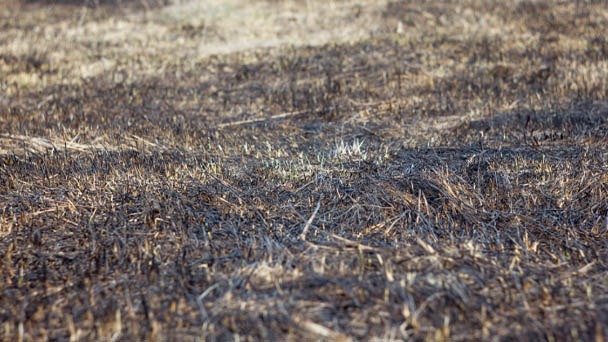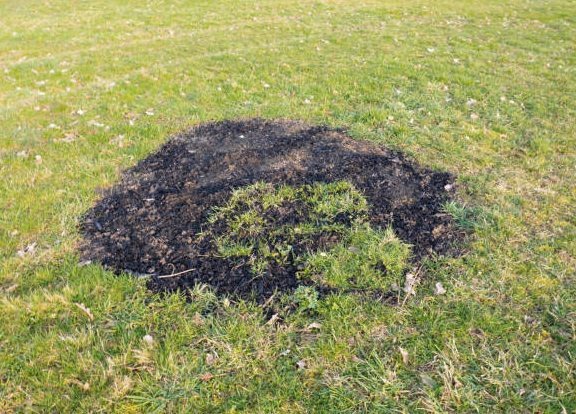How to Fix Your Burnt Grass - Get Your Lawn Green Again
Written by Ivy
Dec 28 2022

Even if you take meticulous care of your lawn, grass burnout can still occur. Brown, burned-out grass stands out in an otherwise healthy patch of grass, whether it is the result of insufficient watering in one area or the excess nitrogen found in dog urine and lawn fertilizer.
In our guide, you can learn how to fix your burnt grass in the following three situations:
- Fix Burnt Grass from Fertilizer
- Fix Burnt Grass Caused by Dog Urine
- Fix Burnt Grass Caused by High Heat Temperatures
If your grass roots are still alive, watering issues are simple to fix, but what about areas that have burned out because of mineral problems? Due to the nitrogen in pet urine, which causes vegetation to return water to the soil rather than absorb it, browning can occur. This causes the soil to dry out. In addition to excessive nitrogen, other mineral salts can also contribute to lawn fertilizer burn by drying out the grass and giving it a burned-out appearance in general.
What Exactly Does Burnt Grass Look Like?
Grass that appears to have been burned by fire is simply that—grass. Technically speaking, burnt grass can also refer to grass that has been damaged by a fire, but because CrabgrassLawns.com offers professional lawn care advice, I'm using the term to describe areas of your lawn that have turned brown.
What Causes Burnt Grass?
It can be difficult to figure out what causes burnt grass in your lawn or why grass changes color, but the following hints should make it easier for you to do so.
- If the tips of your grass blades are turning brown, then the cause is likely either excess nitrogen or heat burn.
- There can be several causes of brown spots on your lawn like dog urine or animal urine that cause roughly 6″ to 10″ straw-colored patches, poor soil quality, and areas where the pH of the soil may be too high. acidic, or a sprinkler issue if you have one or larger distinct patches.
- Brown patches with white-tipped grass blades could indicate a chemical burn issue, where a weed killer or herbicide was used improperly and has spread to other plants.
- Insects and grubs can cause larger patches of dead or dormant grass.
- Strips of patchy brown grass are generally caused by overfertilizing with nitrogen fertilizer, applying excess fertilizer, or applying the wrong fertilizer for your soil condition.
- If your entire lawn is turning brown or wilting, It's probably going dormant during the summer heat (cool-season grasses) or it needs deep watering.
- Believe it or not, dull mower blades can also your turf to have a brown cast or look ragged and can make your lawn more susceptible to disease.
Will Burnt Grass Ever Come to Life?
The answer to will burnt grass ever come to life depends on the extent of the burns. The grass can be saved if it is still vibrant green and growing excessively quickly (early stage), if there are burns on the tips of the grass blades (middle stage), or if the grass blades are turning yellow or brown (late stage).
In order to ensure that the grass will regrow, you should also examine the roots, particularly the deep ones.

How to Fix Burnt Grass from Fertilizer?
The good news is that there are several solutions available if fertilizer, also known as fertilizer burn from fertilizer application, is what caused the burnt grass.
Although the symptoms of fertilizer burn can vary in severity, discoloration is one telltale sign. Your turf may start to appear a little bit yellow or have brown streaks when your lawn has mild fertilizer burn.
In the event of severe fertilizer burn, your grass will change color to a light brown or tan color. The death of your turf is not inevitable despite the seriousness of fertilizer burn.
The easiest way to check whether burnt grass from fertilizer can be repaired is by taking a look at the root system. There's a good chance you don't have a dead lawn and can repair the burned grass in your turf if the roots appear flexible, moist, and generally healthy.
The recovery time will however depend on the severity of the grass burns, and the first thing to do to kick things off is water, water, and water.
For at least a couple of weeks, you must continuously water to flush the excess salt from the soil. With regards to how much water, apply about an inch per day only to the affected area, because applying water to your entire lawn could cause fungal disease and several other problems.
Check the roots once again in about a week to see if the roots have responded to the watering and if the grass is showing signs of going back to its vibrant, green color or healthy green growth.
Your only choice is to replace the affected grass if the roots' health has declined since the last watering or have completely died. There are right ways and wrong ways to carry out this task.
As the saying goes, "prevention is better than cure" and spot-on lawn advice for preventing fertilizer burn is to stick with slow-release fertilizers, especially for larger-care fertilization. Fast-release lawn care products are an excellent way to quickly add nutrients to your soil, including clay soil and compacted soil, but when you overfertilize, this immediate release of nutrients can have negative effects on your turf.
How to Fix Burnt Grass Caused by Dog Urine?
The majority of people mistakenly believe that dog urine's low pH level causes brown, dead patches of grass, but this is untrue. Despite being a crucial nutrient for plant growth, nitrogen, which is present in high concentrations in dog urine, can harm your grass and cause dead patches when applied in excess.
There are a plethora of ways to fix brown patches of grass resulting from dog urine:
- Start with raking as much dead grass and debris as possible.
- Next, improve the grass growing conditions in the area by applying a thin layer of ground limestone and watering it thoroughly. While the limestone works its magic, be sure to keep your furry friend away from this area. Let this limestone coating rest for roughly a week.
- After a week, apply another thin layer of limestone to the area.
- Spread grass seed over the area. As rain and wind can wash or blow away grass seeds, check the weather before sowing them.
- Water the area deeply daily for 1 to 2 weeks.
Keep your dog away from the area while the grass is growing. Also available are products for preventing dog urine damage to lawns, which can be used gradually.
How to Fix Burnt Grass Caused by High Heat Temperatures?
Grass needs sunlight to survive, just like all other plants do, but too much direct sunlight can burn your turf.
Your turf may become stressed if it is exposed to the sun directly for an extended period of time.
Watering the lawn deeply—between 5 and 6 inches—early in the morning is essential if your lawn is suffering from heat burn brought on by warm weather.
Your lawn can also become stressed if certain lawn care tasks are carried out at the incorrect time of day, like mowing in the late afternoon.
Regardless of whether you live in a warm climate or a cooler climate, the best time to mow your lawn is in the mid-morning and it's important to avoid mowing dormant grass.
Mowing your lawn in the early morning hours, usually between 8 and 10 am, gives the blades time to dry and produce strong, bouncy blades.
How to Fix Burnt Grass Caused by Herbicides?
Herbicide damage is a leading cause of burned grass on your lawn, along with extremely warm weather and excessive heat. Herbicides are effective at keeping a healthy lawn free of weeds, but if they are used improperly, they can quickly turn a green lawn brown and full of dead grass.
To fix herbicide burns, you'll need:
- A dirt rake
- Hoe
- Compost
- Topsoil
- A spreader
- A lawnmower
- Fertilizer
Here are the steps:
- Remove the charred grass with a metal rake or hoe,
- Add compost to improve the quality of the soil in that area,
- Spread the right grass seeds in the area,
- Water the newly seeded area generously.
Herbicide damage is frequently irreversible, leaving you with no choice but to reseed the area with grass seeds.
Risk Factors for Sun-Scorched Burnt Grass
Is there a chance the sun will burn your yard? Your yard is more likely to experience the effects of the sun due to a few factors.
- All day long, grass is exposed to direct sunlight. Even your grass, which loves the sun, might become damaged by the sun if there are no trees to provide shade. Because it receives protection at certain times of the day, you might even notice that the grass at the edge of your home appears healthier. Do you know if your yard qualifies as having full sun?
- You have a hill. Your risk factor can go up on a hill for a variety of reasons. For a lawn to be healthy, water is essential. Water that falls on steep slopes often doesn't have time to soak into the soil before gravity carries it to the bottom of the hill. Additionally, slopes that face south, for instance, receive more sunlight exposure than other parts of your lawn.
- Certain areas have been compacted. Once more, it all comes down to the water! Water cannot reach the grass roots in your lawn's compacted areas in a sufficient amount. A heavy object left on your lawn or a recurring short cut through your yard could cause compaction.
Final Thoughts
Burnt grass can occur for a variety of reasons, some of which are fixable. In the worst-case scenario, all you'll need to do is reseed the area and adhere to the proper lawn care regimen to stop further problems, like burnt grass.
FAQs
How to Fix Burnt Grass in Summer
Watering your heat-burnt grass is one of the best ways to green up the brown areas in your lawn. Providing frequent, heavy applications of water that completely saturate the root zone of your lawn's brown patches is the best watering technique for warm weather.
How Long Does It Take Burnt Grass to Grow Back
Your lawn should return to its normal green in 8 days as long as you continue watering it in the morning during this time and your soil is healthy.
Latest Updated
- Benefits of Bugleweed - 7 Science-backed Health Benefits
- Bugleweed Dangers & Side Effects - Is It Poisonous?
- How to Plant Evergreen Trees - What You Should Know
- When to Plant Evergreens - Grow Guide for Evergreen Trees
- 12 Wonderful Evergreen Shrubs for Your Garden
- 12 Popular Evergreen Plants with Pictures for Beginners
- When And How To Prune A Lilac Bush Like a Pro
- How to Grow & Care for Lilac Vine (Hardenbergia Violacea)
- Japanese Lilac Tree (Syringa Reticulata) Care & Propagation Guide
- Shumard Oak Pros and Cons - What to Know
Popular Articles
- Winter maintenance of Antirrhinum Majus
- How to Grow Terminalia Mantaly Tree
- How to Grow and Care for Crossostephium Chinense
- How to grow Antirrhinum Majus in spring
- Peristeria Elata (Dove Orchid) Profile: Info & Care Guide
- Underwatered Snake Plant (Sansevieria Trifasciata) - Signs And How To Fix
- How to Care for Brazilian Jasmine Plant (Mandevilla Sanderi)
- How to Grow & Care for Graptopetalum Purple Delight in Summer
- Rosa Chinensis (China Rose): Plant Growing & Care Tips
- How to Care for Baby Sun Rose (Aptenia Cordifolia)